Indianz.Com >
News > Tribal community celebrates first Indigenous Peoples’ Day in Nebraska
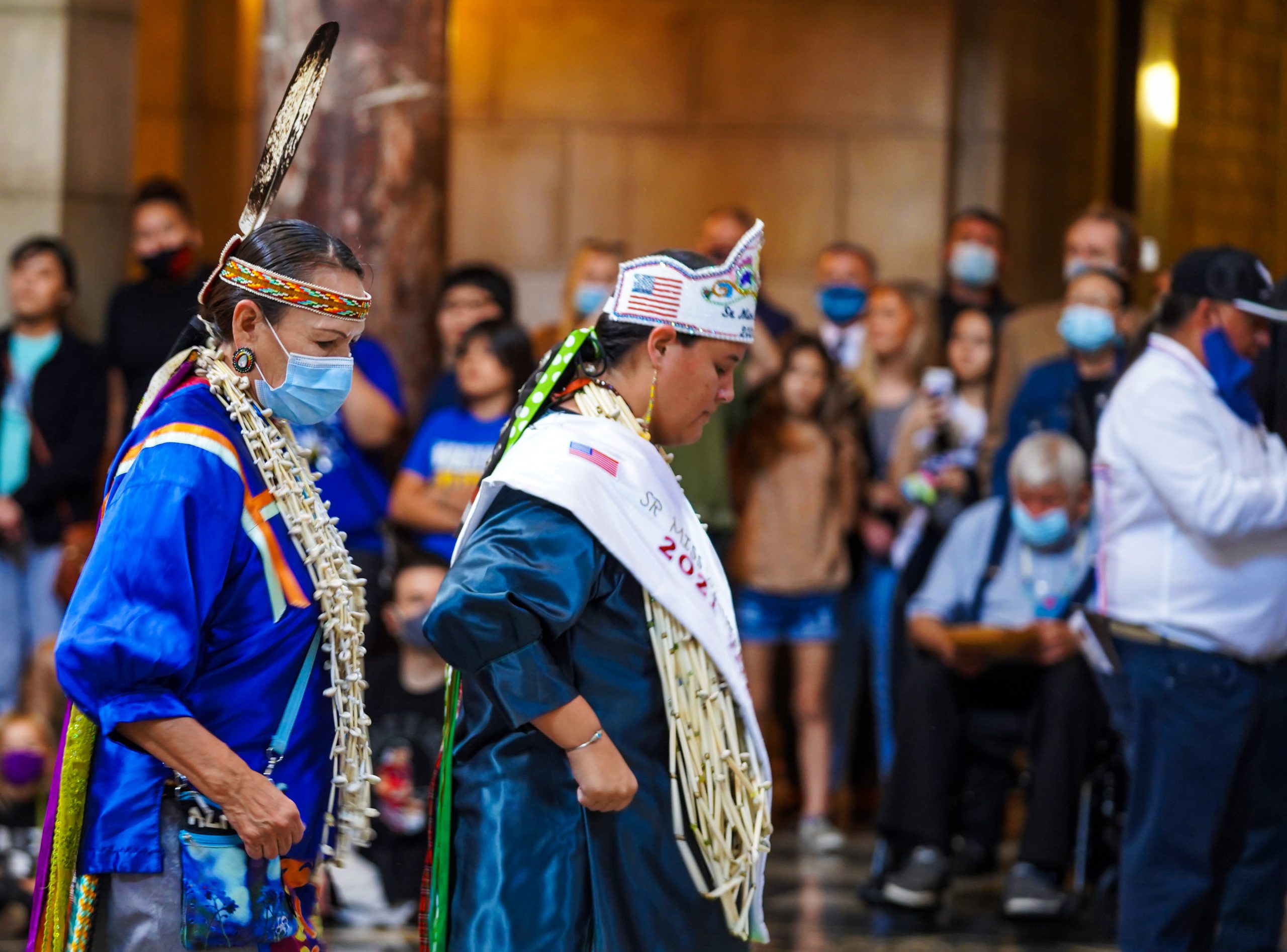 Native dancers perform during Indigenous People’s Day events inside the Nebraska State Capitol in Lincoln, Nebraska, on October 11, 2021. Photo by Kevin Abourezk
Native dancers perform during Indigenous People’s Day events inside the Nebraska State Capitol in Lincoln, Nebraska, on October 11, 2021. Photo by Kevin Abourezk
‘Today is our day’
Tribal community celebrates first Indigenous Peoples’ Day in Nebraska
Tuesday, October 12, 2021
Indianz.Com
LINCOLN, Nebraska — Tribal leaders, state officials and descendants of America’s first indigenous doctor
celebrated Nebraska’s first Indigenous Peoples’ Day on Monday with song, words and cultural presentations.
They gathered in the Capitol Rotunda, members of the state’s four federally recognized tribes – the Omaha, Santee, Winnebago and Ponca people. They sang at drums. They carried flags representing the four tribes, flags that will remain permanently in the state Capitol following legislation passed in 2020.
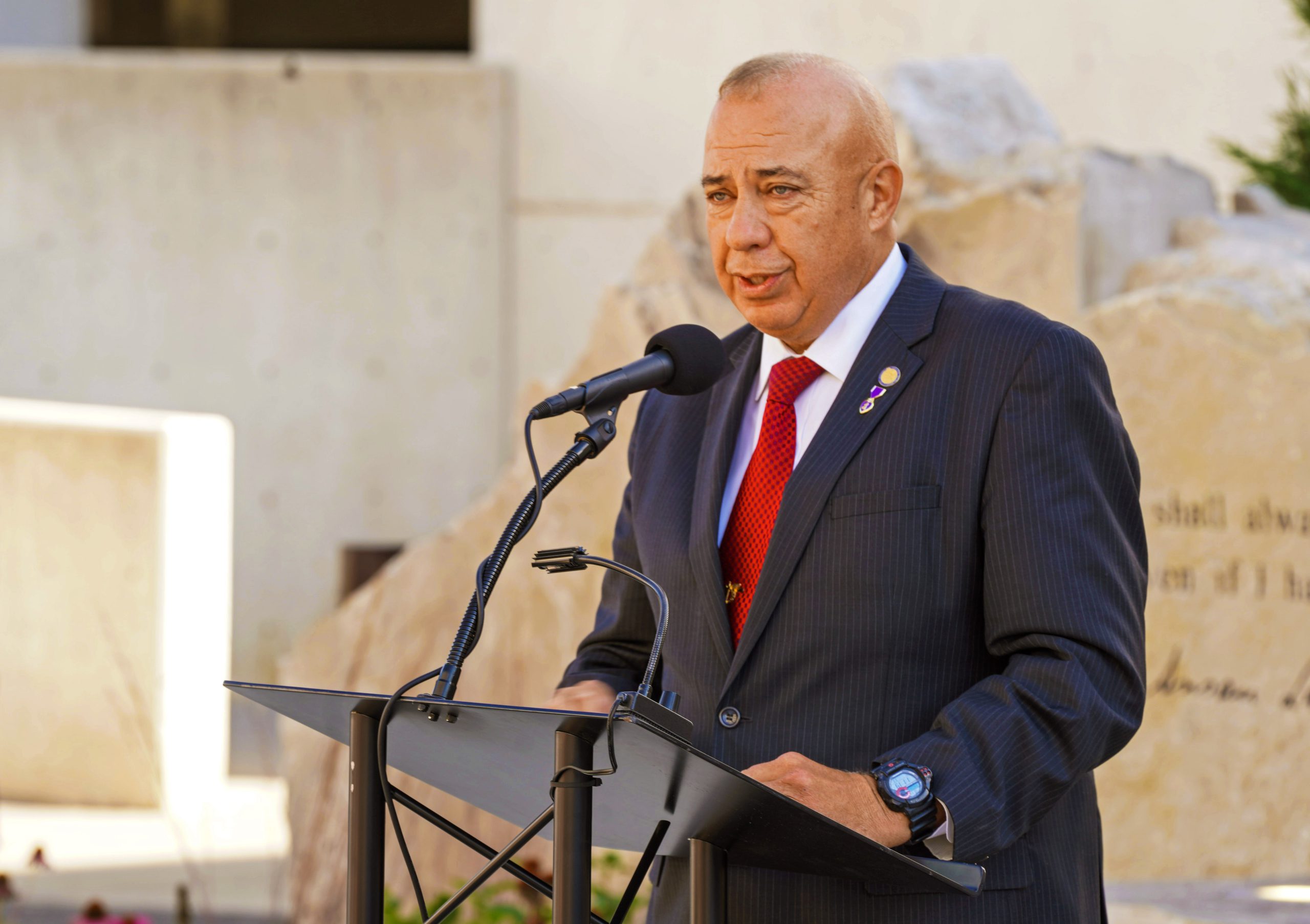 Nebraska state Sen. Tom Brewer, his state’s first indigenous state senator, speaks during Indigenous People’s Day events outside the Nebraska State Capitol in Lincoln, Nebraska, on October 11, 2021. Photo by Kevin Abourezk
Nebraska state Sen. Tom Brewer, his state’s first indigenous state senator, speaks during Indigenous People’s Day events outside the Nebraska State Capitol in Lincoln, Nebraska, on October 11, 2021. Photo by Kevin Abourezk
The state’s first Native state senator, Tom Brewer, sponsored the amendment that led to the four tribes’ flags being permanently displayed in the Capitol. He attached the amendment to a bill establishing Indigenous People’s Day.
“Just one person doesn’t get very much done in the Nebraska Legislature,” he said. “It takes a lot of help from a lot of folks. This day, when we’re putting flags in the Capitol, has been a long time coming.”
State Sen. Patty Pansing Brooks sponsored the bill creating Indigenous People’s Day in Nebraska.
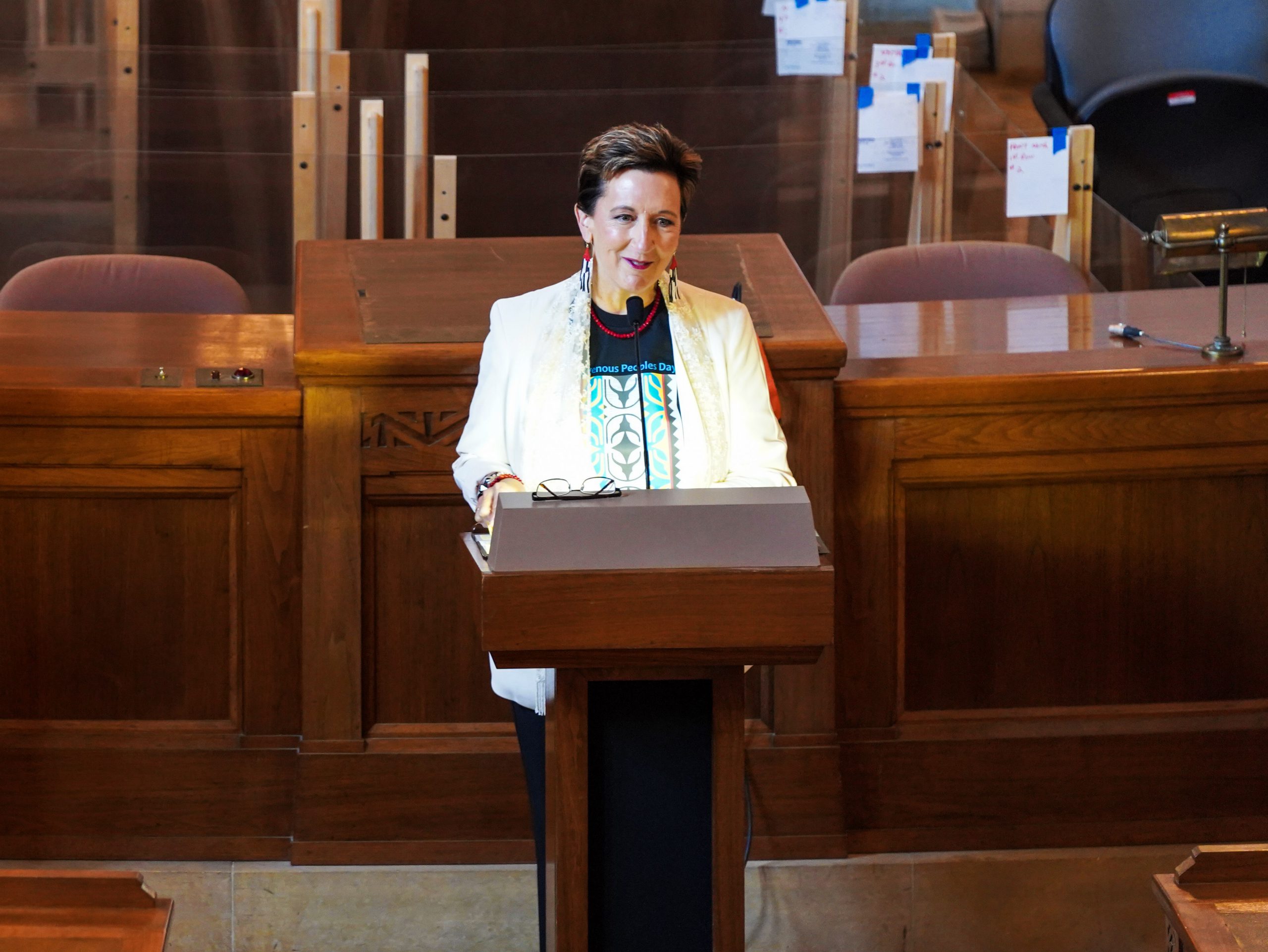 Nebraska state Sen. Patty Pansing Brooks speaks during Indigenous People’s Day events inside the Nebraska State Capitol in Lincoln, Nebraska, on October 11, 2021. Photo by Kevin Abourezk
Nebraska state Sen. Patty Pansing Brooks speaks during Indigenous People’s Day events inside the Nebraska State Capitol in Lincoln, Nebraska, on October 11, 2021. Photo by Kevin Abourezk
On Monday, she called on the hundreds of people gathered before the state Capitol to remember the tragic legacy of European immigrants in America.
“We must learn from those whose relatives first walked this land thousands of years before the Europeans arrived, Europeans who had the audacity to claim proprietorship and kill for that which had never been owned but always honored and revered by the first people,” she said.
“Today is a day to contemplate our past, understand our present and celebrate a more hopeful, brilliant future.”
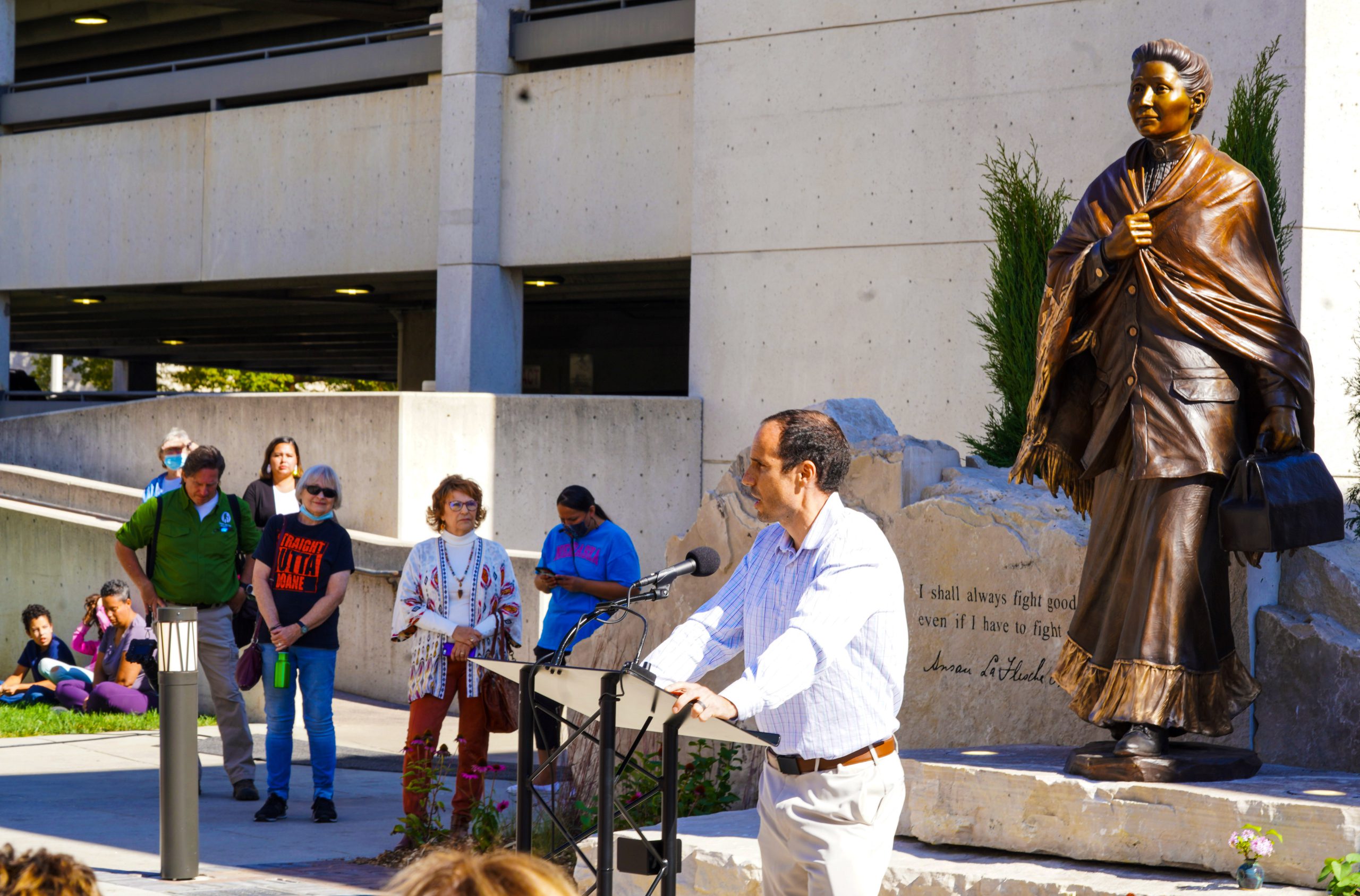 Sculptor Benjamin Victor speaks during Indigenous People’s Day events in Lincoln, Nebraska on October 11, 2021, standing before his sculpture of Susan La Flesche Picotte, the country’s first indigenous doctor. Photo by Kevin Abourezk
Sculptor Benjamin Victor speaks during Indigenous People’s Day events in Lincoln, Nebraska on October 11, 2021, standing before his sculpture of Susan La Flesche Picotte, the country’s first indigenous doctor. Photo by Kevin Abourezk
Monday’s events also included the unveiling of a sculpture of America’s first indigenous doctor, Dr. Susan La Flesche Picotte, who was born in 1865 in an Omaha tipi and earned a medical degree in 1889 at age 26. Despite having the opportunity to remain in the East and pursue a lucrative career, La Flesche returned to the Omaha Reservation to serve her people.
Lincoln Mayor Leirion Gaylor Baird spoke about how La Flesche established the first entirely privately funded hospital on a Native reservation in 1913.
“She also advocated for public health,” Gaylor Baird said. “What an amazing thing that we are unveiling a sculpture of her as we all go through this public global pandemic together.”
“Her inspiring story is one of tremendous sacrifice, fierce determination and selfless commitment to serve others.”
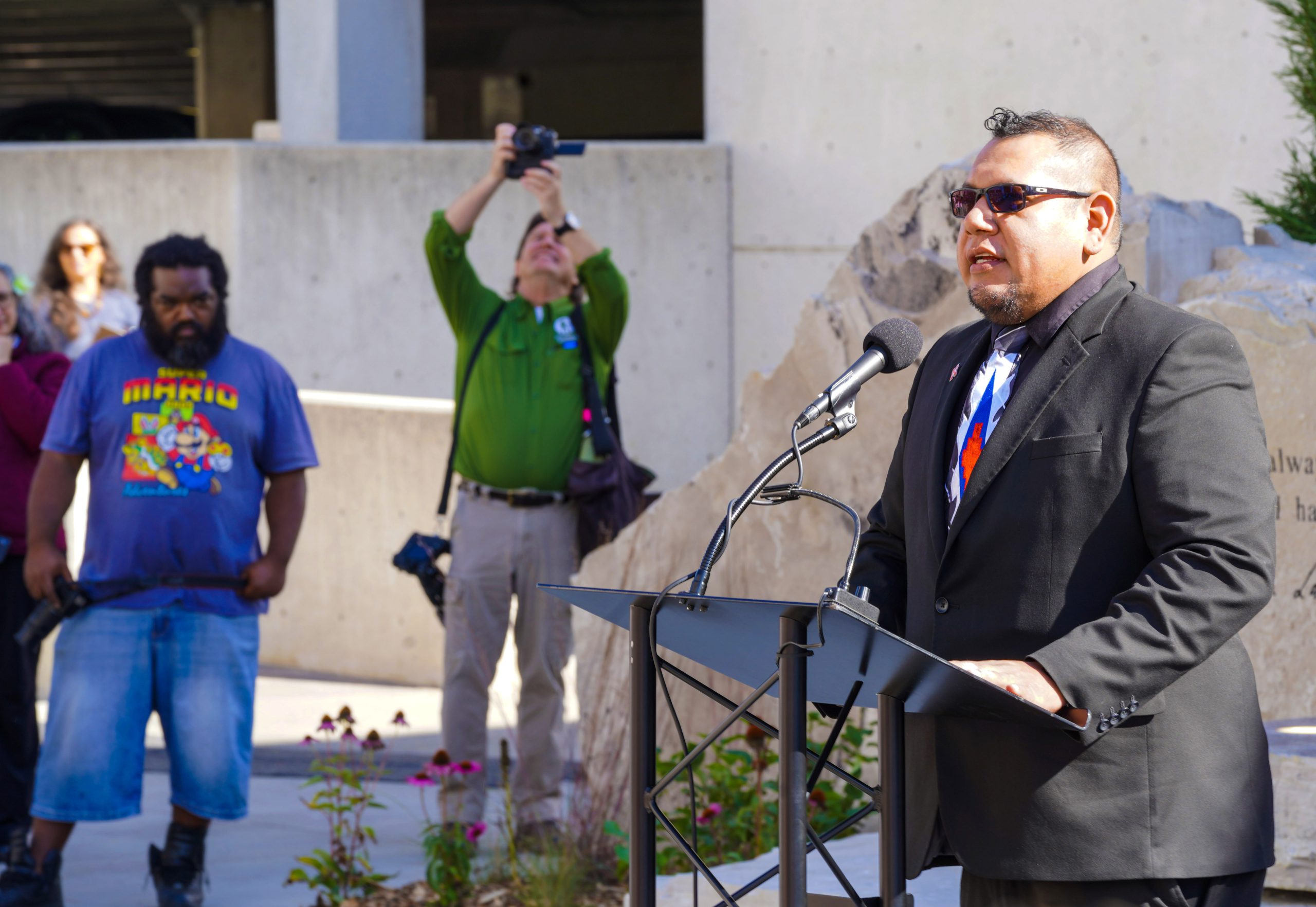 Omaha Nation Chairman Everett Baxter Jr. speaks during Indigenous People’s Day events outside the Nebraska State Capitol in Lincoln, Nebraska, on October 11. 2021. Photo by Kevin Abourezk
Omaha Nation Chairman Everett Baxter Jr. speaks during Indigenous People’s Day events outside the Nebraska State Capitol in Lincoln, Nebraska, on October 11. 2021. Photo by Kevin Abourezk
Everett Baxter Jr., chairman of the Omaha Tribe, said indigenous people shouldn’t only be recognized one day a year.
“Our road hasn’t always been easy,” Baxter said. “It seems we have to push just as hard to move forward, but that’s what our name means. To be Umohon means to go against the current. Today is our day.”
He said he hoped his tribe might one day have one of its members recognized the way that the Ponca Tribe enjoyed national recognition in 2019 when a statue of Ponca Chief Standing Bear was placed in the National Statuary Hall in Washington, D.C.
Standing Bear won a landmark court decision in 1879 that established Native people as “persons” under the law and entitled the same rights as others.
“Our people have survived reservations, forced relocation, forced assimilation, boarding schools and for some of us termination,” said Larry Wright Jr., chairman of the Ponca Tribe. “Today we’re here to celebrate who we are as indigenous people.”
The sculpture of La Flesche by artist Benjamin Victor was commissioned and gifted to the city by Larry Small, a local retired banker. It is located two blocks north of the state Capitol.
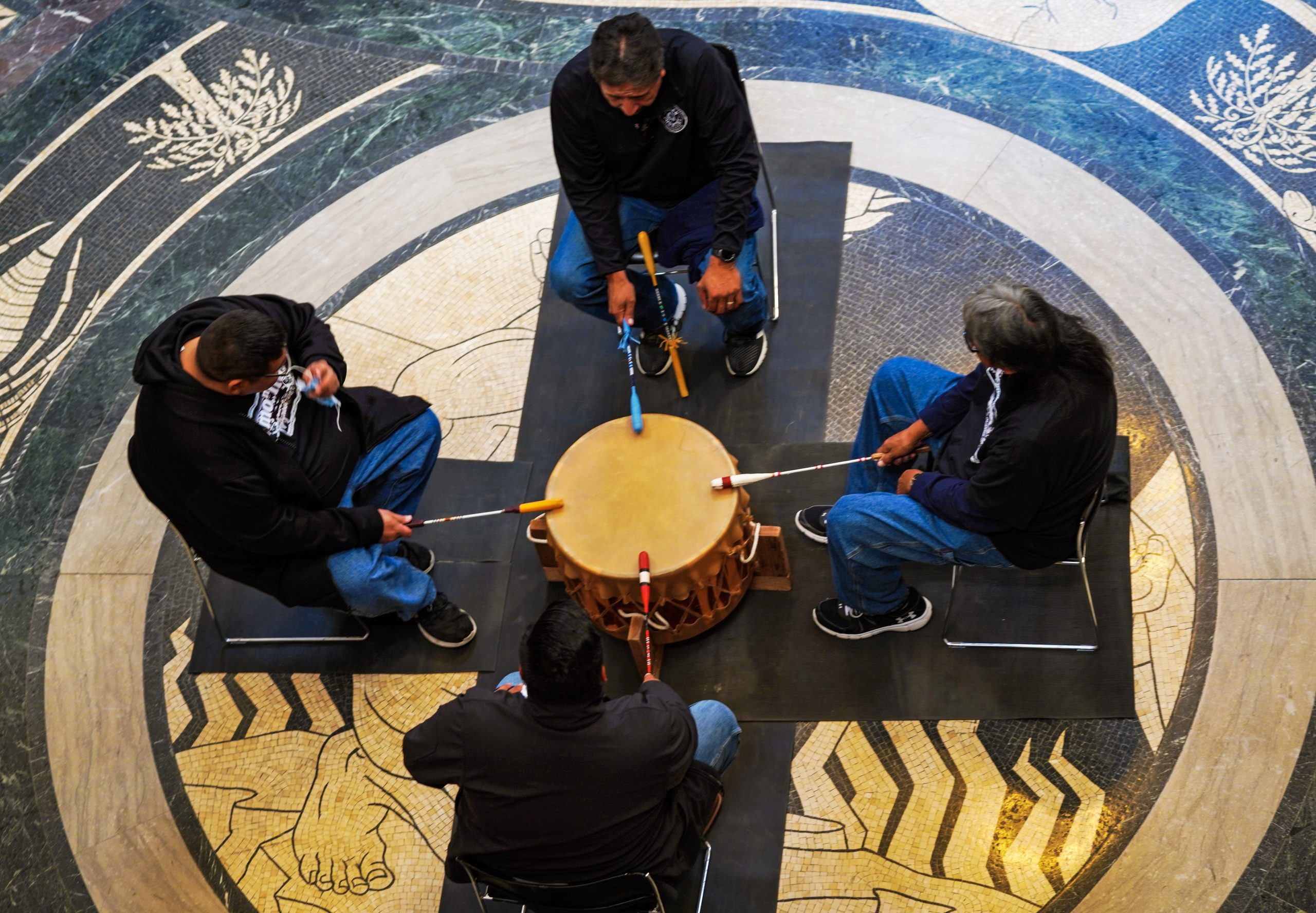 Native singers perform during Indigenous People’s Day events inside the Nebraska State Capitol in Lincoln, Nebraska, on October 11, 2021. Photo by Kevin Abourezk
Native singers perform during Indigenous People’s Day events inside the Nebraska State Capitol in Lincoln, Nebraska, on October 11, 2021. Photo by Kevin Abourezk
Descendants of La Flesche attended Monday’s events, including Susan Picotte, her great-granddaughter, who is a retired nurse now living in Wichita, Kansas. Picotte thanked those who decided to honor her ancestor.
“In French, ‘la flèche’ means ‘the arrow,’” she said. “Susan’s arrow of destiny was pointed toward great things for herself and the Omaha Tribe. She believed that education was exciting and a top priority in a changing world. She used her education to further her commitment to helping her community.”
Indigenous Peoples’ Day in Nebraska
 Native people set up a tipi outside the Nebraska State Capitol prior to the start of Indigenous People’s Day events in Lincoln, Nebraska, on October 11, 2021. Photo by Kevin Abourezk
Native people set up a tipi outside the Nebraska State Capitol prior to the start of Indigenous People’s Day events in Lincoln, Nebraska, on October 11, 2021. Photo by Kevin Abourezk
 A Native woman and girl help set up a tipi outside the Nebraska State Capitol prior to the start of Indigenous People’s Day events in Lincoln, Nebraska, on October 11, 2021. Photo by Kevin Abourezk
A Native woman and girl help set up a tipi outside the Nebraska State Capitol prior to the start of Indigenous People’s Day events in Lincoln, Nebraska, on October 11, 2021. Photo by Kevin Abourezk
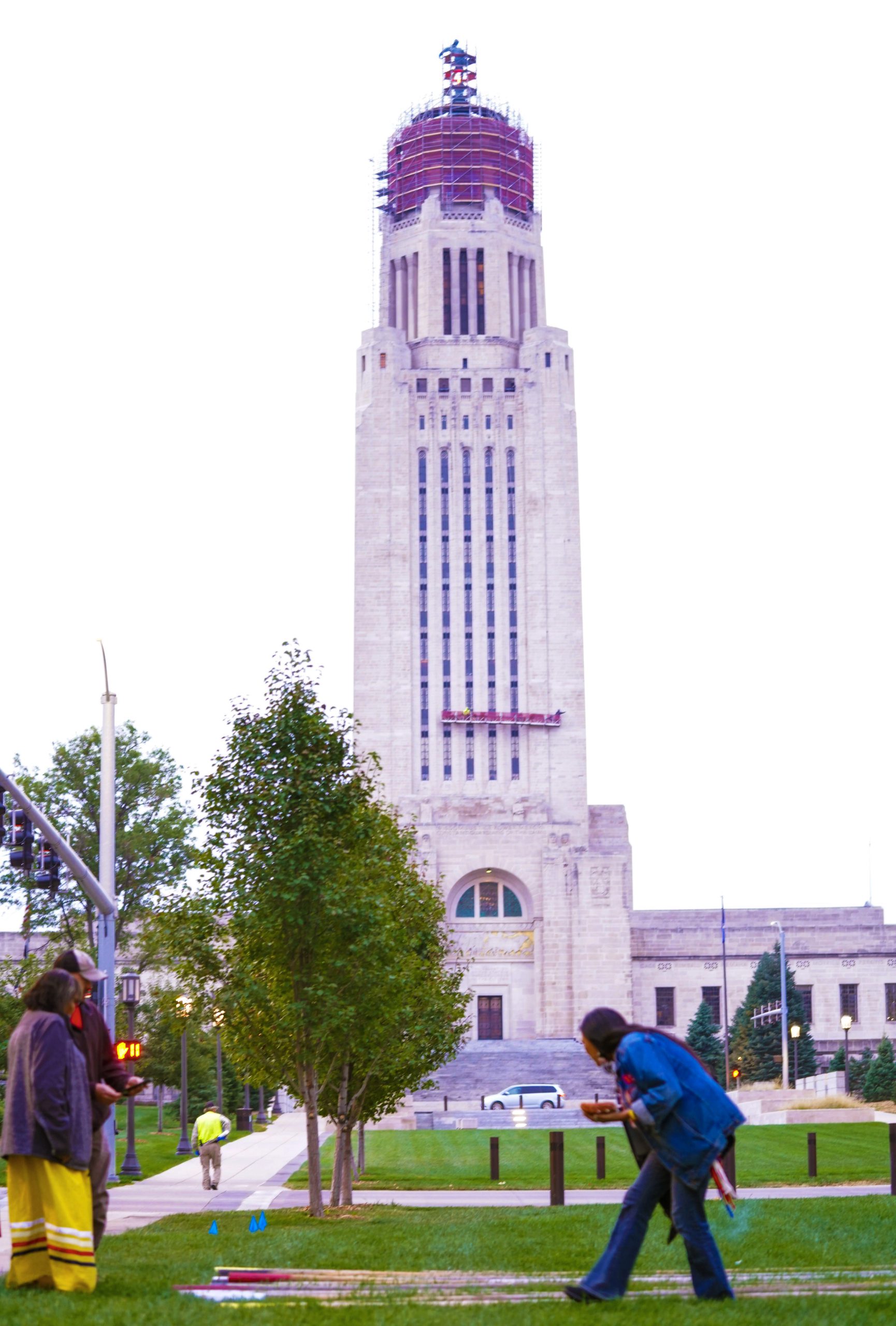 Native people set up a tipi outside the Nebraska State Capitol prior to the start of Indigenous People’s Day events in Lincoln, Nebraska, on October 11, 2021. Photo by Kevin Abourezk
Native people set up a tipi outside the Nebraska State Capitol prior to the start of Indigenous People’s Day events in Lincoln, Nebraska, on October 11, 2021. Photo by Kevin Abourezk
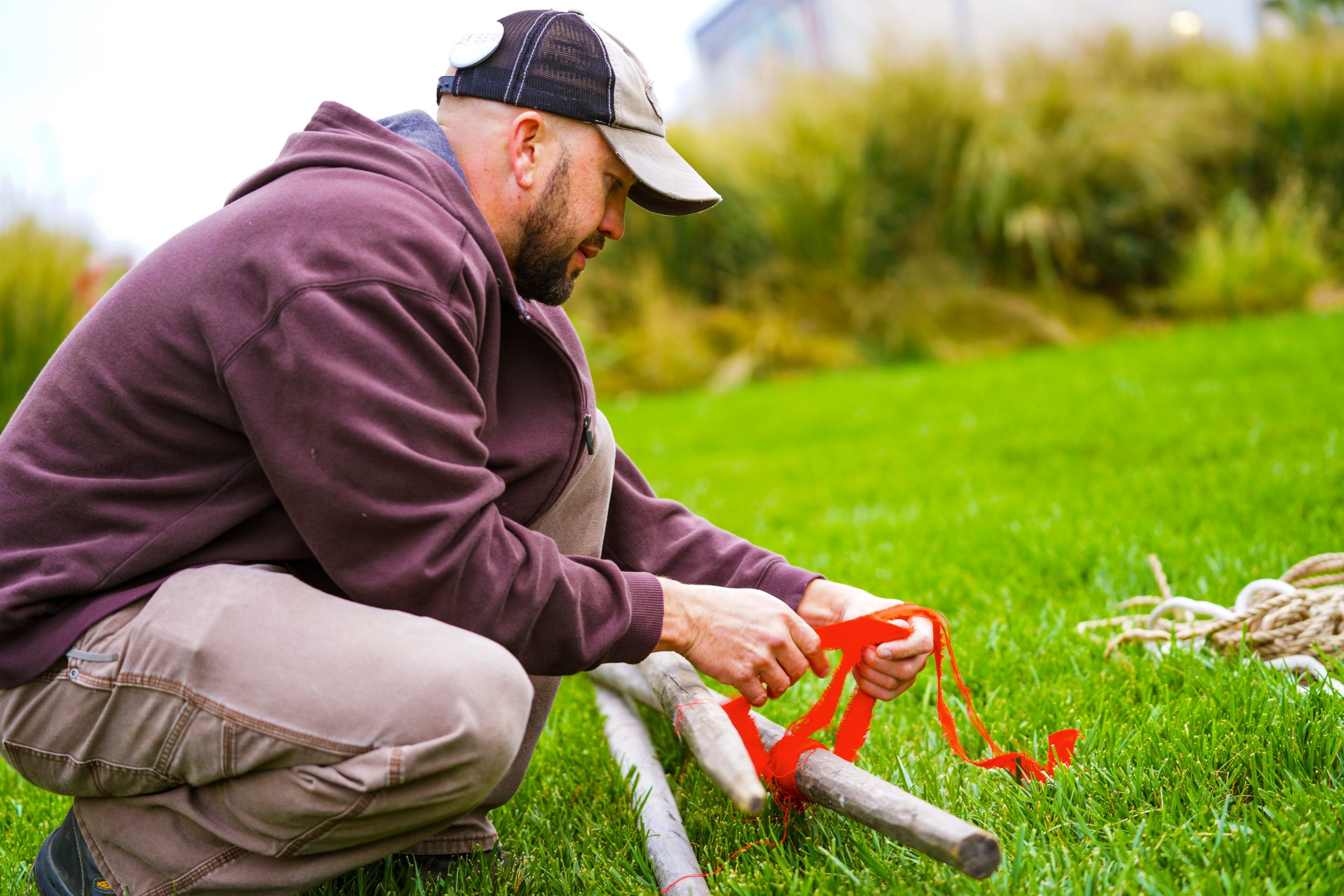 Terry Langan prepares tipi poles outside the Nebraska State Capitol prior to Indigenous People’s Day events in Lincoln, Nebraska, on October 11, 2021. Photo by Kevin Abourezk
Terry Langan prepares tipi poles outside the Nebraska State Capitol prior to Indigenous People’s Day events in Lincoln, Nebraska, on October 11, 2021. Photo by Kevin Abourezk
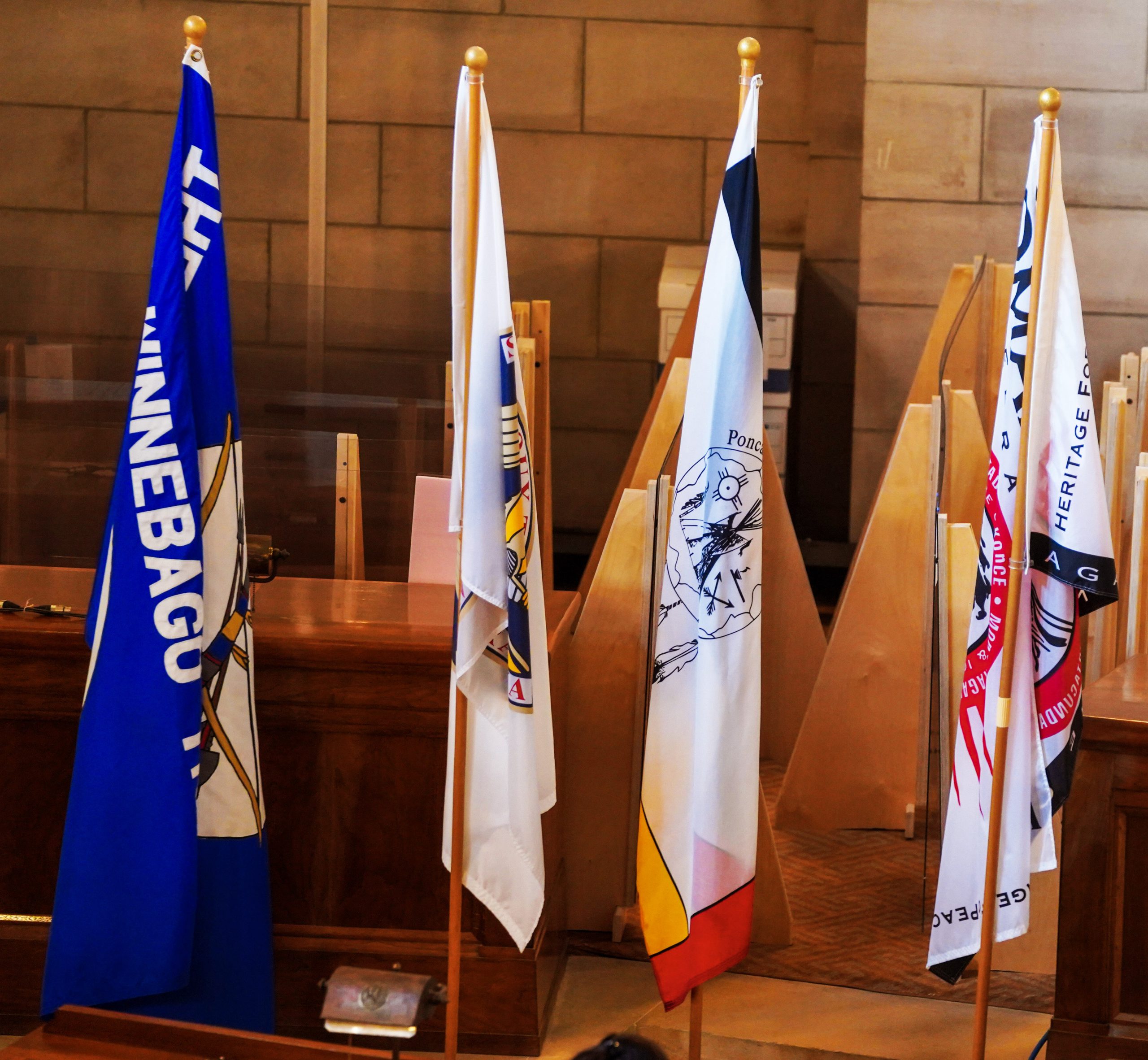 The four flags of the four federally recognized tribes of Nebraska stand inside the state Capitol on in Lincoln, Nebraska, on October 11, 2021. A bill approved last year by the Nebraska Legislature will place the four flags permanently inside the Capitol’s main legislative chamber. Photo by Kevin Abourezk
The four flags of the four federally recognized tribes of Nebraska stand inside the state Capitol on in Lincoln, Nebraska, on October 11, 2021. A bill approved last year by the Nebraska Legislature will place the four flags permanently inside the Capitol’s main legislative chamber. Photo by Kevin Abourezk
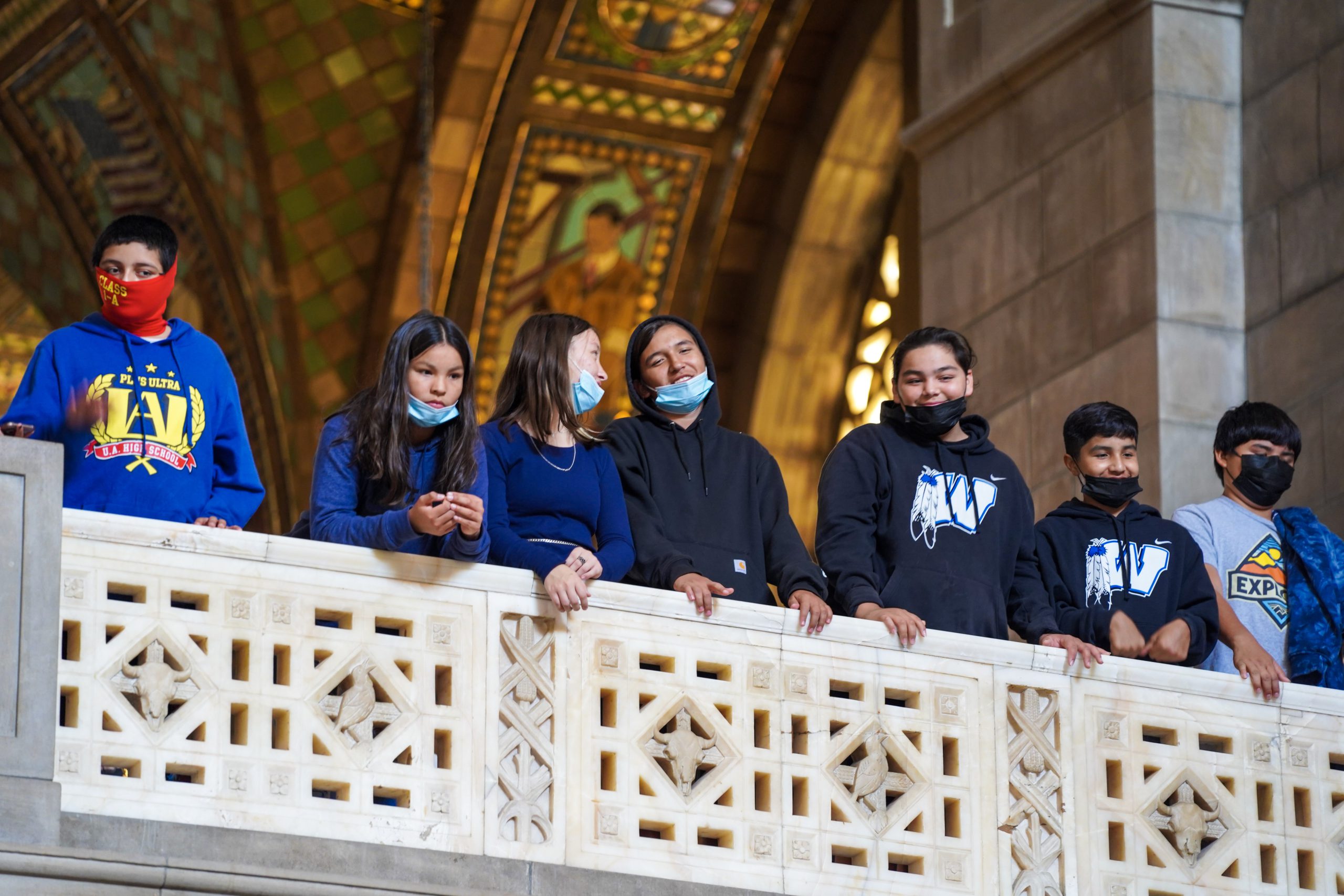 Students from the Winnebago Tribe watch Indigenous People’s Day events at the Nebraska State Capitol in Lincoln, Nebraska, on October 11, 2021. Photo by Kevin Abourezk
Students from the Winnebago Tribe watch Indigenous People’s Day events at the Nebraska State Capitol in Lincoln, Nebraska, on October 11, 2021. Photo by Kevin Abourezk
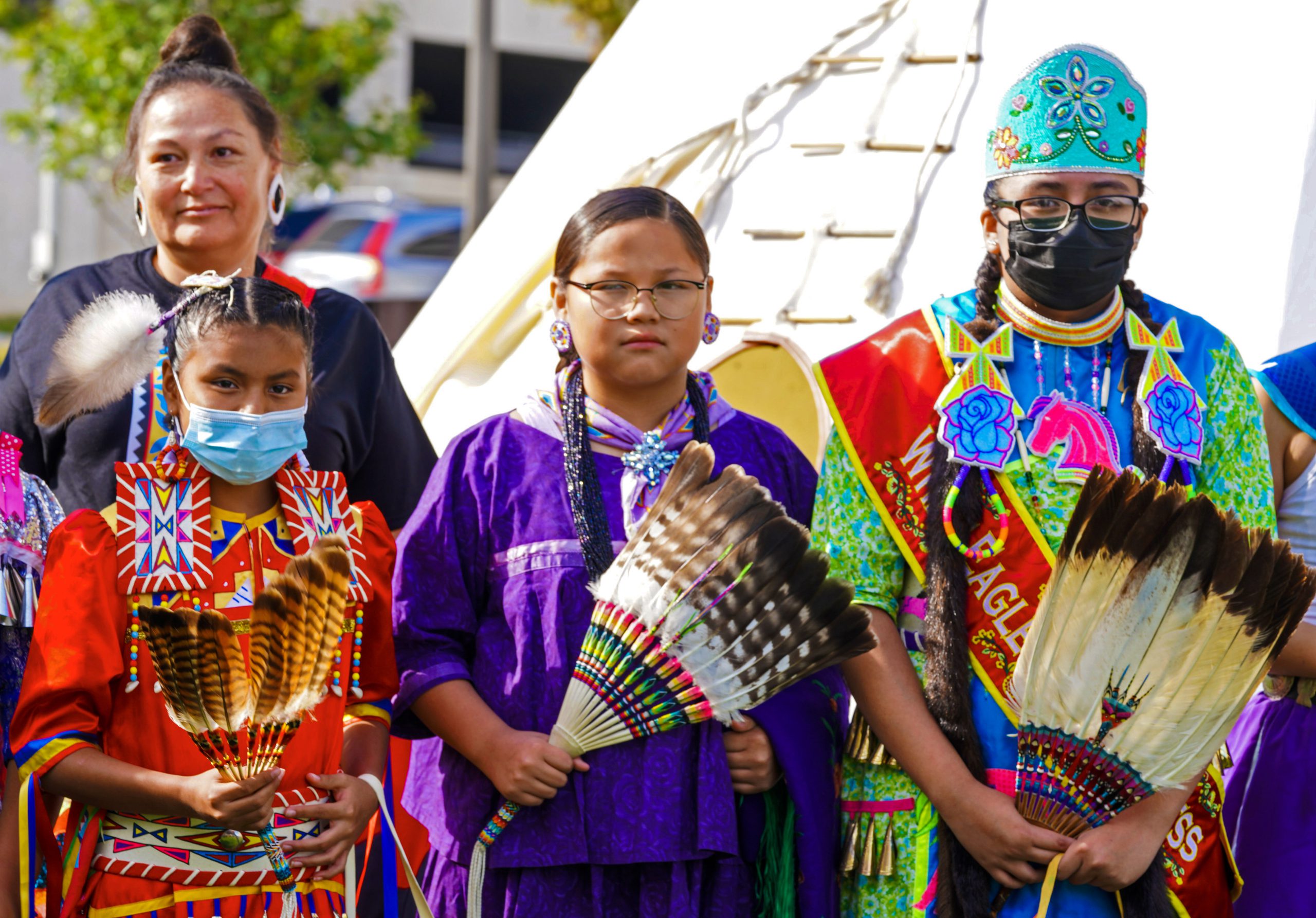 Youth from the Omaha Nation prepare to dance during Indigenous People’s Day events outside the Nebraska State Capitol in Lincoln, Nebraska, on October 11, 2021. Photo by Kevin Abourezk
Youth from the Omaha Nation prepare to dance during Indigenous People’s Day events outside the Nebraska State Capitol in Lincoln, Nebraska, on October 11, 2021. Photo by Kevin Abourezk












